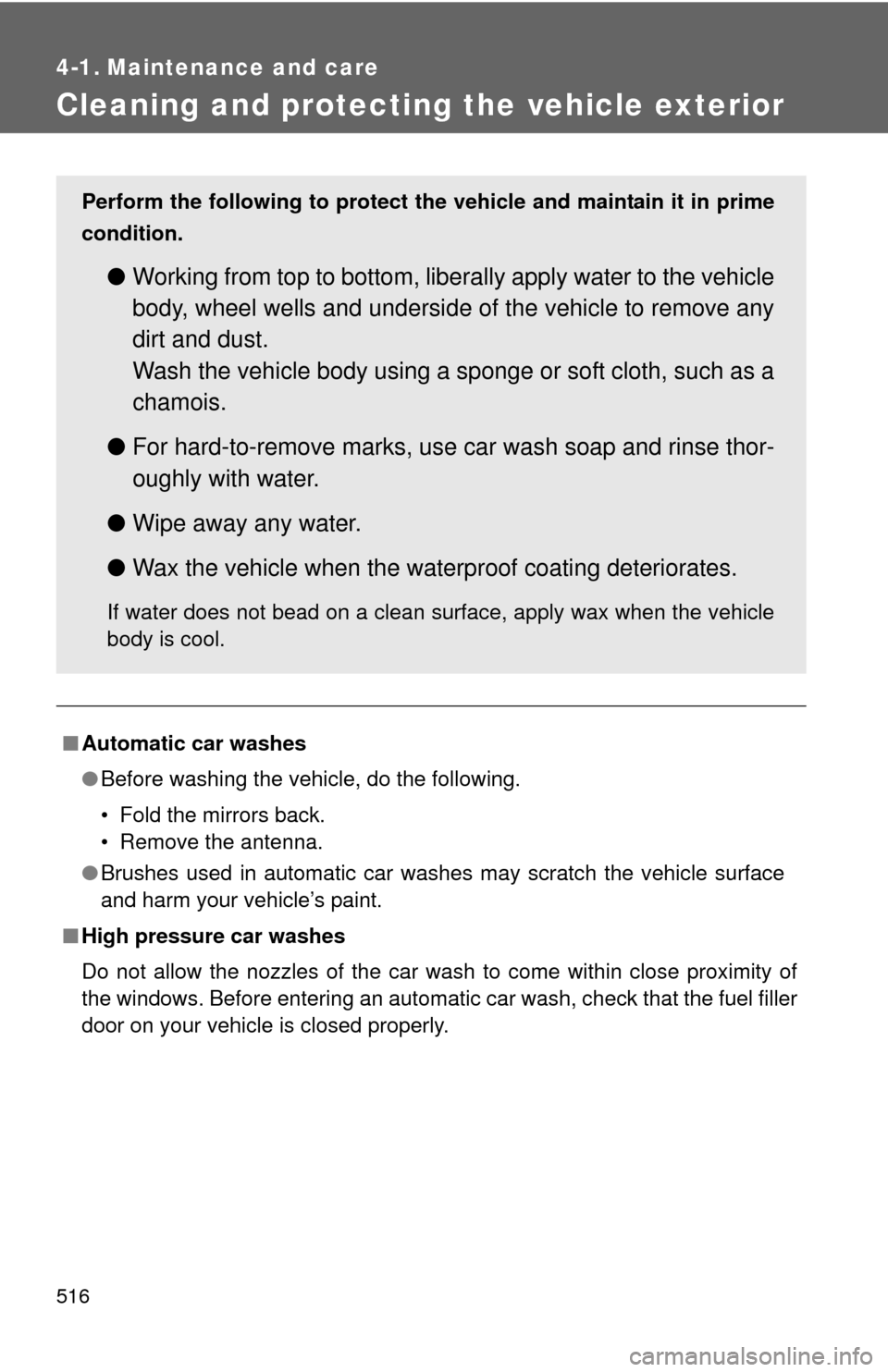Page 5 of 732

1
2
3
4
5
6
7
5
Compass ............................. 510
4-1. Maintenance and care Cleaning and protecting the vehicle exterior............ 516
Cleaning and protecting the vehicle interior............. 519
4-2. Maintenance Maintenance requirements ..................... 522
General maintenance.......... 524
Emission inspection and maintenance (I/M)
programs........................... 527
4-3. Do-it-yourself maintenance Do-it-yourself service precautions ....................... 528
Hood ................................... 532
Engine compartment ........... 533
Tires .................................... 547
Tire inflation pressure ......... 554
Wheels ................................ 558
Air conditioning filter............ 560
Wireless remote control battery ............................... 563
Checking and replacing fuses ................................. 565
Light bulbs........................... 576 5-1. Essential information
Emergency flashers............ 588
If your vehicle needs to be towed........................... 589
If you think something is wrong ............................... 595
Fuel pump shut off system .............................. 596
Event data recorder ............ 597
5-2. Steps to take in an emergency If a warning light turns on or a warning buzzer
sounds... .......................... 599
If a warning message is displayed (vehicles with
multi-information
display) ............................. 608
If you have a flat tire ........... 612
If the engine will not start.... 628
If the shift lever cannot be shifted from P ................... 630
If you lose your keys........... 633
If the vehicle battery is discharged........................ 634
If your vehicle overheats .... 637
If the vehicle becomes stuck ................................. 640
If your vehicle has to be stopped in
an emergency .................. 641
4Maintenance and care
5When trouble arises
Page 9 of 732
9
Tires
●Rotation
● Replacement
● Inflation pressure
● Information
P. 547
P. 612
P. 554, 665
P. 672
Fuel filler door P. 107
Back windowP. 98
Side doors P. 47
: If equipped
Tailgate P. 52
License plate lights P. 212
Stop/tail and rear side
marker lights
P. 212
Rear turn signal
lights
P. 189
Cargo lamps P. 450
Page 11 of 732
11
Tires
●Rotation
● Replacement
● Inflation pressure
● Information
P. 547
P. 612
P. 554, 665
P. 672
Fuel filler door P. 107
Back window
Power back window
P. 98
P. 99
Side doors P. 47
: If equipped
Tailgate P. 52
License plate lights P. 212
Rear turn signal
lights
P. 189
Cargo lamps P. 450Stop/tail and rear side
marker lights
P. 212
Page 13 of 732
13
Tires
●Rotation
● Replacement
● Inflation pressure
● Information
P. 547
P. 612
P. 554, 665
P. 672
Fuel filler door P. 107
Power back windowP. 99
Side doors P. 47
: If equipped
Tailgate P. 52
License plate lights P. 212
Rear turn signal
lights
P. 189
Cargo lamps P. 450Stop/tail and rear side
marker lights
P. 212
Page 192 of 732
192
2-2. Instrument cluster
Gauges and meters
Vehicles with multi-information display
The following gauges, meters and displays illuminate when the
engine switch is in the ON position. Tachometer
Displays the engine speed in revolutions per minute.
Speedometer
Displays the vehicle speed.
Fuel gauge
Displays the quantity of fuel remaining in the tank.
Vo l t m e t e r
Displays the charge state.
Engine oil pressure gauge
Displays the engine oil pressure.
Engine coolant temperature gauge
Displays the engine coolant temperature.
Odometer/trip meter switching and trip meter resetting button
Switches between odometer and trip meter displays. Pushing and hold-
ing the button will reset the trip meter when the trip meter is being dis-
played.
Page 195 of 732
195
2-2. Instrument cluster
2
When driving
Fuel gauge
Displays the quantity of fuel remaining in the tank.
Voltmeter (if equipped)
Displays the charge state.
Engine oil pressure gauge (if equipped)
Displays the engine oil pressure.
Engine coolant temperature gauge
Displays the engine coolant temperature.
Odometer/trip meter switching and trip meter resetting button
Switches between odometer and trip meter displays. Pushing and hold-
ing the button will reset the trip meter when the trip meter is being dis-
played.
Odometer/trip meter
Odometer:
Displays the total distance the vehicle has been driven.
Trip meter:
Displays the distance the vehicle has been driven since the meter was
last reset. Trip meters A and B can be used to record and display differ-
ent distances independently.
Automatic transmission fluid temperature gauge (if equipped)
Displays the automatic transmission fluid temperature.
Page 516 of 732

516
4-1. Maintenance and care
Cleaning and protecting the vehicle exterior
■Automatic car washes
●Before washing the vehicle, do the following.
• Fold the mirrors back.
• Remove the antenna.
● Brushes used in automatic car washes may scratch the vehicle surface
and harm your vehicle’s paint.
■ High pressure car washes
Do not allow the nozzles of the car wash to come within close proximity \
of
the windows. Before entering an automatic car wash, check that the fuel filler
door on your vehicle is closed properly.
Perform the following to protect the vehicle and maintain it in prime
condition.
● Working from top to bottom, liber ally apply water to the vehicle
body, wheel wells and underside of the vehicle to remove any
dirt and dust.
Wash the vehicle body using a sponge or soft cloth, such as a
chamois.
● For hard-to-remove marks, use car wash soap and rinse thor-
oughly with water.
● Wipe away any water.
● Wax the vehicle when the waterproof coating deteriorates.
If water does not bead on a clean surface, apply wax when the vehicle
body is cool.
Page 556 of 732

556 4-3. Do-it-yourself maintenance
■Tire inflation pressure check interval
You should check tire pressure every two weeks, or at least once a
month.
Do not forget to check the spare.
■Effects of incorrect tire inflation pressure
Driving with incorrect tire inflation pressure ma y result in the following:
●Reduced fuel efficiency
●Reduced driving comfort and tire life
●Reduced safety
●Damage to the drive train
If a tire needs frequent re filling, have it checked by your Toyota dealer.
■Instructions for checking tire inflation pressure
When checking tire inflation pressure, observe the following:
●Check only when the tires are cold.
If your vehicle has been parked for at least 3 hours and has not been
driven for more than 1 mile or 1.5 km, you will get an accurate cold
tire inflation pressure reading.
●Always use a tire pressure gauge.
The appearance of the tire can be mi sleading. In addition, tire infla-
tion pressures that are even just a few pounds off can degrade ride
and handling.
●Do not bleed or reduce tire inflation pressure after driving. It is normal
for the tire inflation pressure to be higher after driving.
●Never exceed the vehicle capacity weight.
Passengers and luggage weight should be placed so that the vehicle
is balanced.